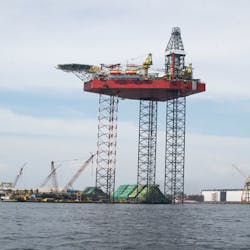Regulatory changes needed to propel E&P investment offshore India
Gurdip Singh, Contributing Editor
India needs to create a more investor-friendly production sharing agreement and assure oil majors of stable policies to attract investment in its offshore sector, says Ravi Sheth, managing director of Greatship (India) Ltd. (GIL), in an exclusive interview withOffshore’s contributing editor Gurdip Singh.
Offshore: Can you give us an overview of GIL’s global oil and gas business?
Sheth: GIL has invested over $1 billion on three jackup rigs and a number of support vessels in drilling services, offshore logistics, and subsea solutions. GIL commenced oil and gas operations in April 2006, and has expanded across Southeast Asia and India.
Offshore: How does GIL see the Indian market?
Sheth: Most of the incremental activity in India is on its east coast. The Ministry of Petroleum has been auctioning acreage, but we have yet to see significant interest from the oil majors. BP’s recent purchase of a 30% stake in the KG fields is encouraging, but to attract greater interest, what we perhaps need is a more investor-friendly production sharing agreement and stable policies. In due course, I am confident that India’s exploration efforts will accelerate, and Greatship will be rightly positioned to take advantage of the growing need for quality services. Moreover, I believe that over time, our aging fields on the west coast will require workover jobs and maintenance of its 30-plus-year subsea infrastructure.
Offshore: How is the company positioning itself to serve the offshore/upstream industries in Asia?
Sheth: We established a fully-functioning marketing operations office in Singapore in 2007. Part of our fleet is flagged in Singapore, and we have all ready operated in Malaysia, Vietnam, Indonesia, Australia, and Brunei. With the operational experience and reputation we have gained so far, I believe we are well placed to serve customers across the region.
Offshore: Are there plans to expand globally in Brazil, Latin America, or the Gulf of Mexico?
Sheth: We have two vessels contracted to Petrobras in Brazil for ROV operations. We are undecided on opening new markets, as we would not like to spread ourselves too thin in the short term. Clearly as our fleet expands, we will service other regions.
Offshore: What are your current assets? How much capacity will be added in the future?
Sheth: Currently, GIL and its subsidiaries own and operate four platform supply vessels, nine anchor handling tug supply vessels, three multi-purpose supply and support vessels, three ROV support vessels, and two jackup rigs. It will add a jackup rig and three vessels to its fleet this year. Our order book includes three ROV support vessels in Sri Lanka, and one 350-ft (107-m) jackup rig in Dubai. In fact, the average age of our vessels is approximately two years, so our young fleet is technologically advanced with state-of-the-art functionalities. Looking ahead, we will ideally like to add to our drilling fleet and own a few more jackups. On the vessel front, we want to assess the supply situation carefully before embarking on our next newbuild program. We have seen a huge increment in shipbuilding capacity, particularly from China. Vessel designs have evolved rapidly over the past decade, and it will be challenging to assess customer needs for the future.
Offshore: What is the capacity range of the current assets in conventional, deepwater, or ultra-deepwater?
Sheth: In drilling, we intend to remain in jackups but perhaps venture into the 400-plus- ft (122-plus-m) water depth range. Our vessels range from mid to large size and are able to serve customers exploring in deeper waters.
Offshore: What are your plans for acquiring new technologies?
Sheth: We have an in-house design department that works actively with yards in planning ships for the future. When we first embarked on our newbuild program in 2006, we planned for special-purpose ships compliance, which in those days, was a concept very few vessel owners knew about. As always, it will be our endeavor to forecast future requirements with a reasonable degree of accuracy.
Offshore: How challenging is it to build manpower expertise in your operations?
Sheth: The Great Eastern Group, the parent [company] of GIL, was the first to own and operate rigs and vessels in India. In many ways, we pioneered the domestic oil field service industry. Owing to that history and the reputation that our group has enjoyed, we have been a preferred employer, both for offshore and onshore personnel. Our fleet is also the youngest, which is an attraction for those who want to develop skills in the technology curve. The Great Eastern Institute of Maritime Studies near Mumbai, which is operated by The Great Eastern Shipping Co. Ltd., has trained close to 2,000 seafarers in various disciplines since it began in 2006, and takes on an average of 400 students a year.
Offshore: What is your assets management strategy? Sell and lease-back to manage high capital costs?
Sheth: Owing to the strength of our balance sheet, we are able to raise conventional asset financing very competitively.
Offshore: Do you have merger and acquisition plans as part of your future expansion, or will organic growth help you become an international player?
Sheth: We are open to any opportunities that come our way. Historically, we have grown organically, but we also recognize the need to acquire skill sets in the offshore space. Hence, we may consider an acquisition if it enhances value.
